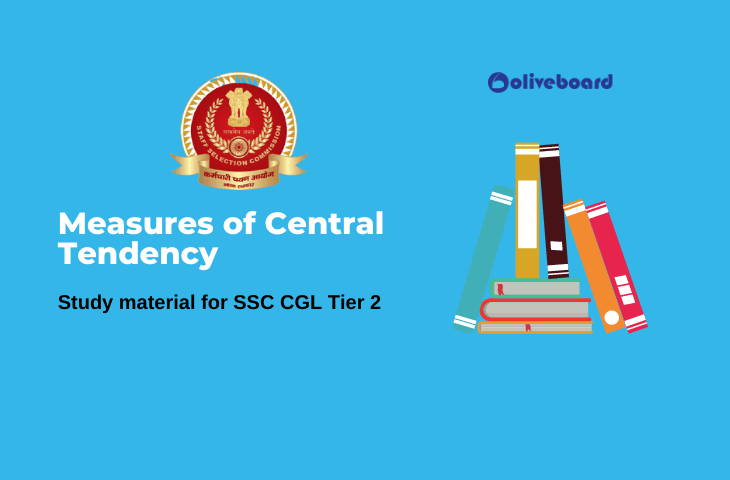SSC CGL exam is conducted to hire personnel for government jobs in various government departments. SSC CGL exam is conducted in 4 phases or tiers. The SSC CGL Tier 2 exam consists of 4 papers: Quantitative Ability, English Comprehension, Statistics, General Studies ( Economics and Finance). Paper 3 of SSC CGL Tier 2 is Statistics and measures of central tendency is an important topic for statistics paper.
Measures of Central Tendency
A measure of central tendency is a single value that tries to describe a complete data set by the process of identifying central positions within such data sets. In statistics mean, median and mode are the three most common measures of central tendency.
Let us now learn about the three measures of central tendency in detail below:
Mean
Mean is the most common of the measures of central tendency. In statistics, the mean is usually referred to as the arithmetic mean. Mean can be used to calculate both discreet as well as continuous data. However, most often it is used for calculating continuous data sets.
In other words, the mean represents the sum of all values in a dataset divided by the number of values in the data set
It can be said that
Mean = Sum of all the values in a dataset / Total number of data values
Steps to calculate mean
Count the total number of data values and represent them as x1, x2 etc.)
Calculate the sum of all the data values (represented as )
Mean is denoted by the following formula
Or, it can be represented with the following formula
OR
In the case of data presented in a tabular form, the following formula is used to calculate the mean
Mean = ∑f x / ∑f
Where ∑f = N
N = Total number of observations
Median
Median is defined as the middlemost value that is obtained after arranging the observations in ascending or descending order.
For example, consider this data 3,4,7,9,6
On arranging the data in ascending order we get,
3,4,6,7,9
In the above data set 6 is the middlemost value as it falls in the middle of other observations. Now, let’s see how we can determine the median in the case of grouped and ungrouped data.
Grouped Data
When the data presented is continuous and in the form of a frequency distribution, then the median can be calculated as follows:
Step 1: Find the median class
Now N = Total number of observations or sum of all the frequencies
Median is the middlemost value; therefore, a median class will be the class where the value of N/2 lies
Step 2: Now, in the case of grouped data, the median can be calculated using the following formula
Where,
l = Lower limit of the median class
c = Cumulative frequency of the class preceding or before the median class
h = Class size
f = Frequency of the median class
Ungrouped Data
For calculating the median of ungrouped data, the following steps are observed:
1. Arrange the data in ascending order
2. Assume the total number of observations as N
Now we have to see if the total number of observations(n) is odd or even
In case n is odd
Then median = (n + 1)/2th observation
In case n is even,
Then median = mean of (n/2)th observation and [(n/2)+1]th observation
Mode
Mode is referred to as the observation that occurs most frequently in a data set or we can say mode is the observation with the highest frequency. The mode can be calculated for grouped and ungrouped data.
Grouped Data
Grouped data is said to be formed when the data is continuous. In such cases, the mode can be found out by first finding the modal class and then using the formula
Where
l = Lower limit of modal class
fm= frequency of modal class
f1= frequency of class preceding modal class,
f2= frequency of class succeeding modal class
h = class width
Ungrouped Data
For ungrouped data, the observation that occurs the maximum number of times is considered as mode.
How to Download Measures of Central Tendency E-book?
Step 1: Click on the download link. You will be redirected to Oliveboard’s FREE E-Books Page.

Step 2: Create a free Oliveboard account or login using your existing Oliveboard account details
Step 3: Download the book by clicking on the link presented on the page.
Conclusion
SSC CGL Tier 2 exam is very important for the candidates and scoring well in this phase paves the way for progress to further phases. Statistics paper in SSC CGL Tier 2 is important for the JSO post. We hope that the blog on mean, median and mode will help candidates appearing for SSC CGL Tier 2 Statistics in their preparation.
FAQs
The three common measures of central tendency are mean, median and mode.
Mode is that value that occurs most frequently in a data set. In other words, the mode is the observation with the highest frequency in a data set.

Hello there! I’m a dedicated Government Job aspirant turned passionate writer & content marketer. My blogs are a one-stop destination for accurate and comprehensive information on exams like Regulatory Bodies, Banking, SSC, State PSCs, and more. I’m on a mission to provide you with all the details you need, conveniently in one place. When I’m not writing and marketing, you’ll find me happily experimenting in the kitchen, cooking up delightful treats. Join me on this journey of knowledge and flavors!
